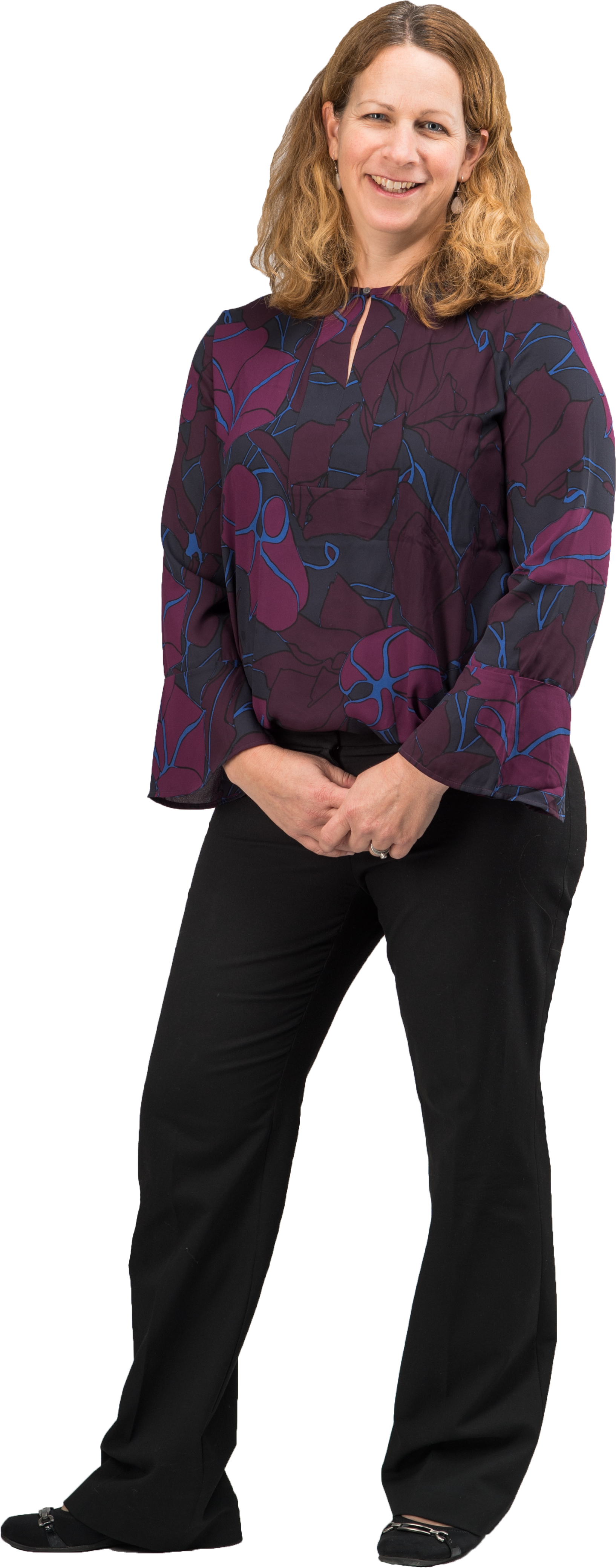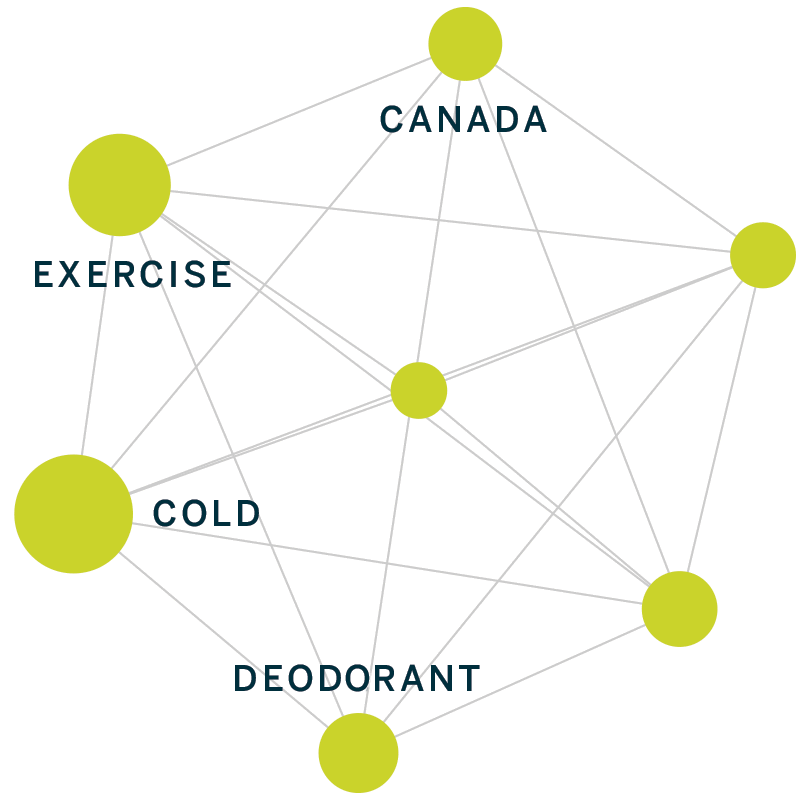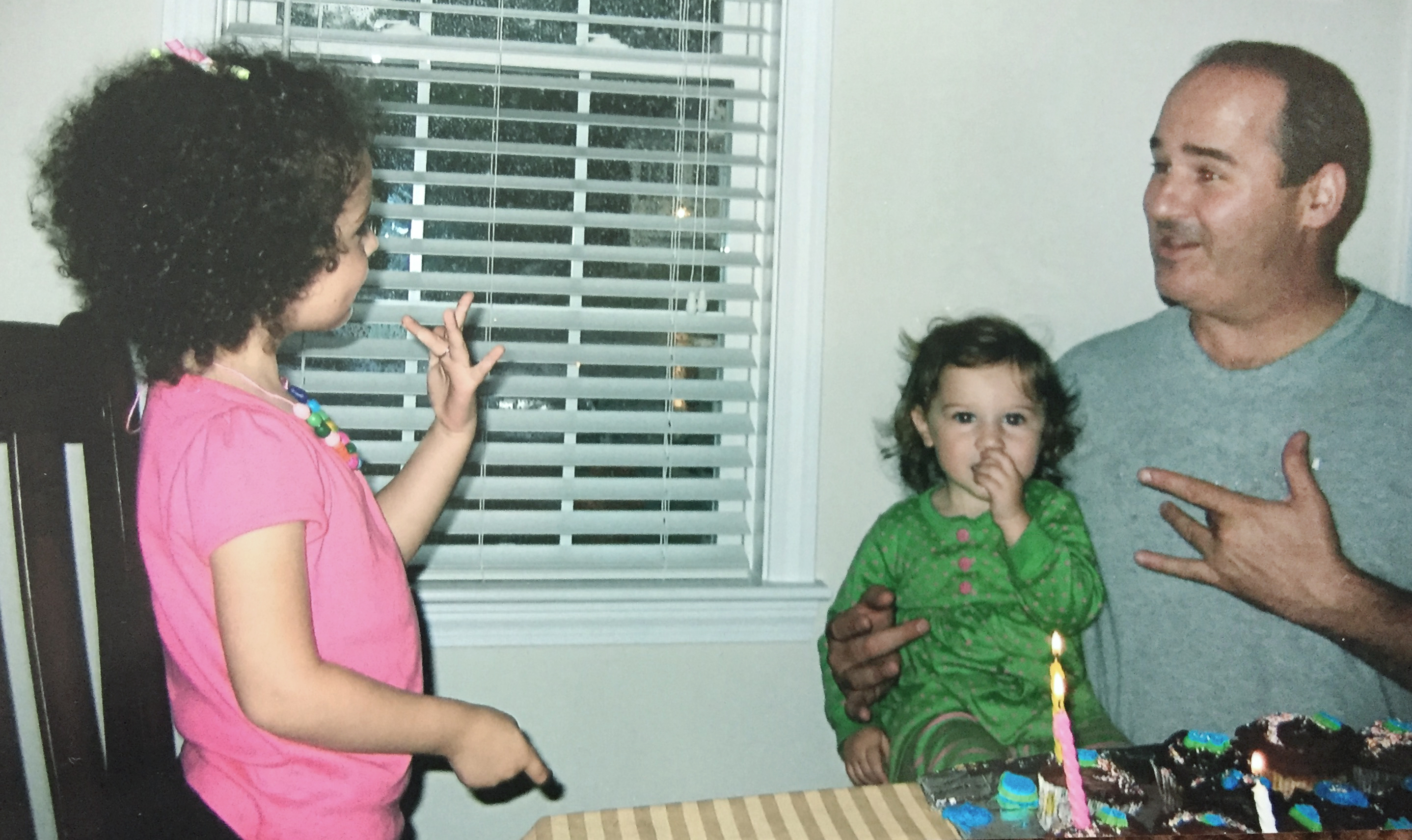What Percentage Of Hearing Parents Learn To Sign
Getting the Discussion In
BU Deaf Studies researchers expect for means to prevent deaf children from being deprived of language.
A few years ago, Naomi Caselli, a Boston Academy Deaf Studies researcher, stumbled upon her father'southward faded grade picture from the 1960s. He stood in the back, a suited boyish in a ocean of elementary schoolchildren. Caselli assumed he was a instructor's aide.
He wasn't. Her father had been held back.
He had lagged behind his peers for a specific reason. Caselli's begetter, Raymond Kenney, is profoundly deaf in both ears. He was in a class for deaf and hard-of-hearing children, merely they didn't teach sign language at that place. Instead, teachers spent years coaching him to speak using concrete and visual cues. Over and over, they sounded out words like 'ball,' repeating 'bah-bah-bah' while holding his paw at their mouths to show him how to mimic the vibrations. "They actually wanted him to speak," says Caselli.

Past age viii, he knew a few basic words, but he could not speak in sentences and used fabricated-upward gestures to communicate with his family. He did larn to read, however, and excelled in math and science every bit a teen.
At historic period 19 at the National Technical Institute for the Deaf at the Rochester Institute of Engineering, he got his first look at American Sign Language (ASL) in practice among other deafened students. "I was enthralled," says Kenney, who immersed himself in learning the language. "A lightbulb went on."
Today, he even so struggles with reading and expressing himself in written English language, frustrations that evoke his childhood, when his power to communicate was so limited. "I'm still connecting to that anger," says Kenney, who is now a Certified Deaf Interpreter.
"He'south a cute signer now," says Caselli, who is hearing but learned ASL alongside spoken English from nascency. "But that'south uncommon for people who've had a like experience."
Today, ASL has been accepted equally a total-fledged language with all of the complexity, structure, syntax, and storytelling found in spoken languages. Likewise, elementary and secondary school programs for the deafened teach and appraise ASL proficiency using accepted measurement tools, some of which were developed at BU.
But language deprivation remains a existent problem for deafened children. "Kids today are still having much the aforementioned experience that my dad did," says Caselli. "It is non a thing of the past."
Many deaf children—maybe as many as 70 percent—are deprived of language
Photograph by The Learning Center for the Deafened
The concern now among researchers like Caselli and Amy Lieberman, assistant professor of deaf studies in the BU School of Education, is what happens before school starts. Approximately xc to 95 percent of deaf children are born to hearing parents who often don't know sign language and therefore volition likely struggle to teach it earlier their children enter school. Even among school-aged deaf children, estimates based on data from a 2010 survey from Gallaudet University, which specializes in deaf education, suggest that at nearly forty percentage of families use sign language at home. Given this data, educators in the field worry that a bulk of deaf children may be deprived of language.

Exposure to language from birth is essential for the development of thinking skills, according to a range of studies. Without admission to linguistic communication, children have a harder time in schoolhouse. They also have more difficulty developing a sense of self and others. They even struggle with planning and time management. "It's a constellation of challenges," says Caselli.
So Caselli, Lieberman, and their collaborators are using the tools of linguistics, behavioral psychology, cerebral science, and education to understand how deaf children acquire linguistic communication and, in turn, how best to teach them. "We desperately need data about this," she says. "We are all the same at the outset stages of identifying the most prevalent bug."
Disquisitional Moments
When Robert Hoffmeister founded the BU Deaf Studies program in 1980, ASL was on the fringes of acceptance. Students at BU could study it, but it did not count every bit a foreign language. "That'south the cloud we lived under for about 25 years," says Hoffmeister, associate professor emeritus of deaf studies. "That cloud was more or less lifted by evidence-based research."
Linguistic analyses showed that ASL is a language, not just a bunch of gestures. It uses infinite, coordinated handshapes and movements, facial expressions, and a unique syntax to build meaning. Together, this visual language has all the structural features found in spoken languages. Information technology also has its own literary traditions. "We accept folklore passed down from generation to generation," says Bruce Bucci, a BU Deaf Studies instructor who is among several deaf faculty members at BU and communicated through an interpreter for this story. "At that place is a visual tradition and culture connected with the linguistic communication."
Credence of ASL every bit a language was a key first step toward preventing linguistic communication deprivation, because information technology validated the educational activity of ASL to deafened babies and children. The developing encephalon responds to language no matter how it is presented, then exposure to ASL is equivalent to exposure to a spoken language. "The aforementioned brain regions and mechanisms perceive and acquire language regardless of the modality," says Lieberman.
At most, 40 pct of families with schoolhouse-anile deaf children use sign language at home
Photo by Cydney Scott
Researchers also learned that language deprivation delays the development of thinking skills. In 2007, Hoffmeister and colleagues studied deaf children'southward development of "theory of mind," the man power to think about other people's thoughts. They institute that children exposed to sign language from birth develop theory of mind quickly with hearing children. Merely children with delayed language exposure also had delays in theory of heed. "You need language to talk about the world," says Hoffmeister, who hears but is a child of deaf parents. "Language was the crucial factor."
Hoffmeister went on to develop ways to assess language conquering in school-aged children. Now enquiry in the Deaf Studies program is shifting the focus to younger children, from birth to age five. This age range is known every bit the critical menstruation of language evolution. During those years, exposure to language triggers all kinds of development. Pull the trigger, and children associate words with things, ideas, and feelings. They course a sense of self and others, an understanding of fourth dimension and planning, and an ability to pay attention and make connections.
On the flip side, without language exposure, children experience a cascade of deficits. "If babies don't take stimulation with language during that critical time of development, then their cerebral development, their thinking skills, and their language evolution are all at stake," says Nicole Salamy, a spoken language and language pathologist at Boston Children'due south Hospital who is also a deaf studies instructor at BU.
Bucci puts it more directly: "If children are deprived of linguistic communication, they will not thrive."
The trouble is that for deaf children, language is visual. It's non passively absorbed every bit the sounds of life occur around them. "When deafened children accept admission to visual language, they tin can navigate their world right away," Salamy says.
"If children are deprived of language, they will not thrive."
Bruce Bucci, deaf studies teacher, Boston University
Language Barriers
Hearing parents of deaf children face all of the challenges of parenthood plus the need to acquire a completely new language for communicating with their child. They too face conflicting advice from health providers, associations, and educators.
Some advocacy and professional person groups counsel against introducing sign language, particularly targeting parents who want to utilise medical interventions such as cochlear implants. Parents are told that sign linguistic communication will distract their child, or that it volition take up infinite in the brain and not leave room for learning spoken languages.

These and other concerns have largely been debunked. In a recent review of enquiry on the field of study, Caselli and her colleagues, Matthew Hall from the University of Connecticut and Wyatte Hall from the University of Rochester Medical Center, show that learning ASL early supports learning a spoken language later, the same style learning one spoken language supports learning a second. "If you understand the structures of one linguistic communication, yous'll be able to use and understand them in another," she says.
There is also a notion that deaf children struggle with reading because they can't audio out words. This connection betwixt written language and sounds is chosen phonological coding. But according to research Lieberman did before she came to BU, this is as well a misconception. "Many skilled deaf readers do not take access to phonological coding," she says. "They conspicuously have alternate routes to reading, most likely having a foundation in sign language."
Ultimately, at that place is no risk to introducing children to sign language. Research shows that the deafened child will only benefit, whether hearing and speech are introduced after or not. "Yous tin can practice both," says Caselli. "You can learn sign language and endeavour to get spoken linguistic communication."
One of the biggest challenges for educators and researchers who want to improve deaf education is figuring out how to detect linguistic communication deprivation. This would not only assistance researchers understand the scale of the problem but also assist them guide deafened children and their parents to services that tin can smoothen the style to introducing sign language.
ninety to 95 percent of deaf children are born to hearing parents who oftentimes don't know sign language
Photograph by The Learning Center for the Deaf
A first footstep, existence taken by Caselli, Lieberman, and Jennie Pyers, a visiting faculty member from Wellesley College, is to develop an ASL exam for children under five. With new funding from the National Constitute on Deafness and other Communication Disorders, part of the National Institutes of Health (NIH), they plan to work initially with deaf children who have deaf parents. "We want to sort out what vocabulary acquisition looks similar under platonic conditions," says Caselli.

From at that place, they volition study deafened children with hearing parents, who probable face bigger challenges and potential delays equally parents learn to sign. "Our goal is to decide where children fall behind and where they don't, then that nosotros can focus interventions," she says.
To support this effort, Caselli developed an online visual lexical database for ASL called ASL-LEX. The tool, which won the People's Choice Award (Interactive Category) in the "Vizzies" Visualization Claiming sponsored by the National Scientific discipline Foundation and Popular Science, documents almost ane,000 ASL signs, forth with data virtually frequency of use, grammar, and hand movements. The database will also become a repository for data about milestones, such as the age at which children larn different signs. This data, in plough, tin can become a source for building cess tools.
Attending-Getters
For parents of deaf children, chore i—aside from learning the language itself—is getting the child'due south attention. "Information technology seems simple, but parents demand to learn how to manage their child's gaze," says Lieberman.
Deaf babies who learn sign linguistic communication from their parents learn to manage their attending past the fourth dimension they reach preschool, according to earlier research past Lieberman. "They wait up to run across a sign and down to connect the sign to an object," she says. "They do and so in meaningful and purposeful ways."

Since eye movements reveal a lot about how deaf children procedure and learn language, Lieberman developed a set of studies using techniques that rails eye movements and is continuing this research with a grant from the NIH. She and her enquiry team, which includes both deafened and hearing researchers, are focused on deaf children as young as 18 months and upwards to five years to understand how and when they larn words.
The study will include both deaf children with deaf parents and deaf children with hearing parents. "We want to look at the full spectrum of deaf children, looking carefully at the quantity and quality of language exposure they're receiving," says Lieberman. "How practice those two measures correlate with the ability to develop visual attending skills and new words?"
Not only will this research help develop milestones for detecting language deprivation, it will also aid develop interventions for children who are falling behind. An outcome could be an educational program, or tips for parents that help them manage their child'south gaze. "Without looking, there'south no language," says Lieberman.
Explore Related Topics:
Source: https://www.bu.edu/articles/2017/asl-language-acquisition/
Posted by: ortegaandutimmose.blogspot.com


0 Response to "What Percentage Of Hearing Parents Learn To Sign"
Post a Comment